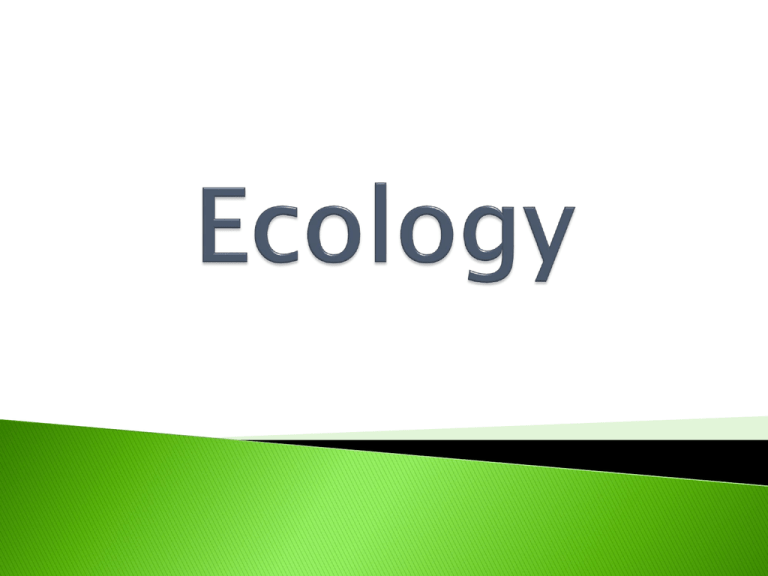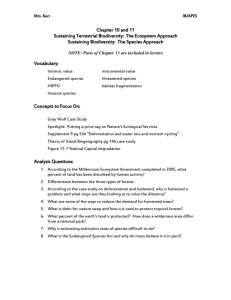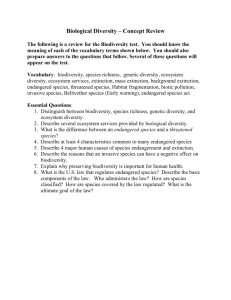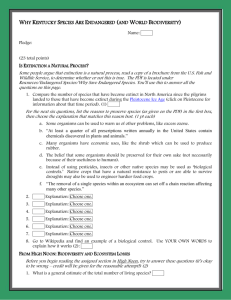Sci10Ecology
advertisement

Ecology = The study of the interaction of living and non-living things in their environment. Biotic = Living things Ex: plants/animals Abiotic = non-living Ex: Water/sunlight Alexander von Humboldt: •"the unity of nature” • interrelation of biology, meteorology, geology etc. Charles Darwin: •“organisms adapt to their environment” Organism Population Community Ecosystem Biome Organism: a single living thing. Population: a group of organisms of the same species. Community: all of the different organisms and populations in an ecosystem. Ecosystem: all of the living and non-living things in an areas and their interactions. Biome: Huge ecosystems defined by the plant life found there. Ex: Tundra, rainforest, deciduous forest etc. Rare and significant changes in the way that humans view the world. Major changes which are controversial at first but come to be accepted as major advancements in scientific knowledge and understanding. Old World View: New World View: Earth is flat Earth is round Earth centered universe Sun centered solar system Creationism Evolution Spontaneous generation Biogenesis Right now…. Resources are limitless Sustainability Green Technology Still in progress? Discuss & Answer: 1. How is it possible that people believe(d) that resources are limitless? 2. Do we still have people thinking this way today? 3. Why have we shifted to this new paradigm? 4. Is this paradigm still in the process of shifting? 5. What controversy is there regarding this new paradigm? What would it look like? End of Easter Island (3 mins) Discovered by Dutch explorer on Easter Sunday, 1722. Desolate, treeless, 64 square mile island. Deforestation/extinction of palm tree had lead to collapse of the native civilization who lived there. Trees were used to build boats, monuments etc. In a span of about 400 years, the seemingly limitless resource had been used up. This is seen as a small-scale example and warning of what we are doing to Earth today. 1. Why is it so surprising and unusual that frog species worldwide are disappearing? 2. Why are scientists so concerned about the disappearance of frogs? (What’s the big deal?) 3. Describe each of the four reasons why scientists think they are disappearing. Malaria: The winged scourge Answer questions 1, 2, and 3 on page 13. 1. What is meant by the term ‘spaceship Earth’? 2. What is the difference between a man-made spaceship and the planet Earth? 3. What factors determine the diversity of life on our planet? 4. Where on Earth do we find the most biodiversity? (Explain why) 5. Where on Earth do we find the least biodiversity? (Explain why?) Science 10 Assignment: Unit: Ecosystems Topic: Endangered Species -Choose an endangered species from the website below and begin researching information: http://www.earthsendangered.com/index_s.asp -For the species you have been given, you will be graded on your ability to answer the following questions: a) What is/are its habitat(s)? (Where exactly in the world is it found, and describe the particular habitat) b) What is its place in the food chain? Is it a herbivore, carnivore, omnivore? What are its natural predators (if any), what are its prey (if any)? c) What are the factors that have made it an endangered species? (What has caused it to become endangered?) d) What (if anything) is being done to try and save the species? (How are people trying to protect this organism from extinction?) e) Why we should be concerned about their disappearance (What would we lose? Why are they important?) *You will also create a 3-D model of your organism from materials of your choice. *You will present your information to the class as a short presentation. *Be sure to provide me with your sources of information as well (web addresses, book title etc). *Value: 2 points for each question (10 total) and 10 points for your model. Total value of 20 points. Due date:_____________________________ My species is: _________________________________ Extinct: A species that no longer exists anywhere on Earth. (Ex: dinosaurs) Endangered: A species that is close to becoming extinct in a large area (such as a country). Extirpated: Any species that no longer exists in one part of Canada (or country) but exists in others. Ex: Grizzly bears no longer in Manitoba, but in Alberta. Threatened: Any species that is likely to become endangered if factors that are harming it are not reversed. Ex: Wood Bison is threatened by tuberculosis. Vulnerable: A species that is at risk due to low or declining numbers. Ex: grey fox Mass Extinctions (Nova Science Now) 208 mya, 80% of all species died and dinosaurs began their rule of Earth 65 mya, age of dinosaurs ended Asteroid collision evidence in Mexico (Yucatan peninsula) High amount of Iridium, in underwater crater -Smoke and debris in atmosphere blocks out sunlight, plants die and food chain collapses. -Tsunamis, earthquakes, volcanic eruptions, forest fires etc. Threatened Trophic level Producer Extirpated Autotroph Vulnerable Albedo Ecotone Heterotroph Artificial ecosystem Biotic Endangered Primary consumer Herbivore Biodiversity Carnivore Natural ecosystem Biomass Omnivore Secondary consumer Abiotic Photosynthesis Habitat Extinct Pest Decomposer Thermodynamics Detritus Community Ecology Ecosystem Gradual climate change (temp, moisture etc). Species’ being outcompeted (food, territory etc). Species must adapt or die out. 8000 BCE – 1600 CE (about 1 species extinction every 1000 years) 1600 – 1900 (1 species every 4 years) Since then, 1 species every 30 mins? How are humans causing mass extinctions today? Habitat destruction Pollution Overhunting Global warming Create a placemat to answer the following questions (pages 42-44). 1. a) What does the term “exotic species” mean? B) Where did the zebra mussel come from? 2. How did the zebra mussel get into the Great Lakes? 3. Create a list of positive effects of its introduction to the Great Lakes. 4. List of negative effects. Killer Bees introduced into Brazil from Africa. Idea was to increase honey production. Imported bees outcompeted other species of bees. Overall honey production in Brazil dropped. African bees have killed animals and humans. Continue to spread further north toward Canada. Divide a plain white page into 12 equal squares. Put one of the words below into each square then draw a colored picture to explain what it means. No words allowed in your explanation! Bioamplification Biotic potential Closed population Combustion Emigration Glucose Mortality Natality Open population Pesticide Photsynthesis Immigration “Bill Nye: Biodiversity” Video Worksheet Name _____________________________ 1. For a(n) ____________________ to be healthy, it has to have lots of different kinds of plants and animals. 2. Name four types of ecosystems from those listed in the video. a. b. c. d. 3. All living things depend on _______________________________________________. 4. Name four extinct species. a. b. c. d. 5. The best way to wipe out a species is to ______________________________________. 6. The largest ecosystem in the world is the ______________________________. 7. ______% of the world is covered by water. 8.________ of all the species in the world live in the ocean. 9. List five things you can do to increase biodiversity. A. b. c. d. e. 10. Approximately how many species are we losing per hour? _________ Complete the worksheet for pages 50 and 51, as well as 62-64. This worksheet covers information for: A) nutrient cycling B) The carbon cycle Bioamplification Biotic potential Closed population Combustion Emigration Glucose Mortality Natality Open population Pesticide Photosynthesis Immigration Carbon cycle Carrying capacity Cellular respiration Denitrification Densitydependent factor Denistyindependent factor Fertilizer Inorganic Law of the minimum Law of tolerance Nitrogen cycle Nitrogen fixation Nutrient Organic Peat Pest Nitrogen atoms are: A) Needed for cells to make proteins and DNA B) 79% of our atmosphere (N2 gas) Changed from N2 to NO3-a form living things can use- by some soil bacteria (Process called nitrogen fixation) Converted back to N2 gas in a process called denitrification, done by another kind of bacteria. Phosphorous atoms are: A key element in things like: a) cell membranes, b) DNA, c) bones Found in rocks, then dissolved by erosion, then algae and other plants absorb it (enters food chain). Animals use it to make bones and shells which become bedrock over a long periods of time. Once brought to surface, process of erosion starts again Use your textbook as a guide to fill out the diagrams for the Carbon, Nitrogen and Phosphorous cycles. Carbon cycle: Page 62 Nitrogen cycle: Page 66 Phosphorous cycle: Page 68 Food Chain Game: "Chain Reaction" Purposes: 1) Save crops from weeds, moulds, insects etc. 2) Fight infectious diseases such as malaria by killing their insect vectors (carriers) 500 BCE-1900’s: Things like sulfur, arsenic, lead, mercury etc Found to be poisonous to humans! 1900’s: -People stop using these things. -But sometimes still found in soil/plants. Made in labs 1930’s: DDT introduced WW2: DDT popular to protect troops from insects in jungles Thousands of lab-made pesticides today, used mostly for agriculture Bioamplification: Toxin (pesticide) levels increase in concentration as it moves up the food chain. Top predators = highest concentration DDT found in humans; banned in Canada-1971 1) Herbicides: kill weeds 2) Fungicides: kill moulds and other fungi 3) Insecticides: kill insects 4) Bactericides: kill bacteria Page 51: 1, 4, 5 Page 65: 1, 2, 3, 4, 5a, 6 Page 69: 1, 7 Page 84: 1 Safer because: Broken down quickly by the liver, or in soil But: More dangerous because: 1) Applied (sprayed) more often 2) Not selective (kill/affect all kinds of organisms) 3) Risk of bioamplification First application doesn’t kill all pests because some are “stronger” and have some resistance. - -This resistance is passed onto future generations (“kids”) and the resistance grows until it is essentially useless in killing the pest. Canada: A People’s History “In an Uncertain World” Scene 10: “From the Ground Up” (about 8 minutes) Use any of your notes or textbook to complete the crossword puzzle. Hand it in to me when finished. (Include your name!!!) While watching the video, try to answer the following questions: 1. Why are bees so important to humans? 2. What are the reasons for their decline in numbers? 3. What are scientists/farmers doing to try to help? 4. What kinds of issues will bees, humans, and the Earth in general face in the future?







